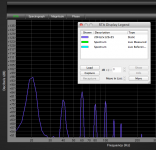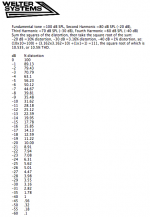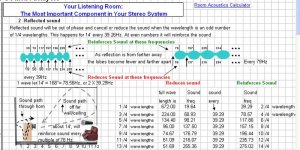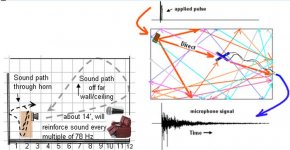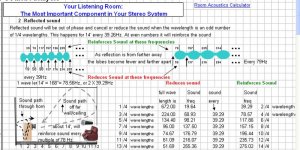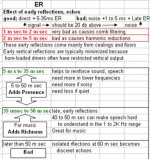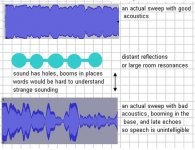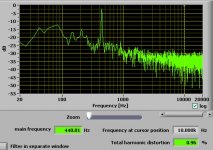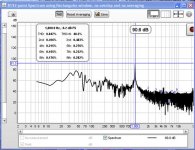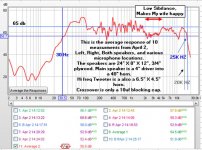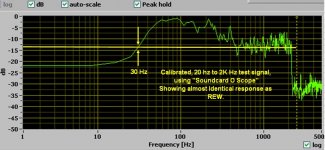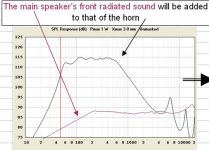a 20 Hz horn is 660 inches long, 55 ft, mouth and long unless 1/4 wave then "only" 13.75 ft long. This is using 13200 in / sec as the speed of sound. My 40 inch horn should end at 330 Hz. using my O-Scope[ www.zetnitz.de/christian/scope_en ]or using [Audacity: Free Audio Editor and Recorder ]I see a 15 HZ wave at the same level as a reference 1K Hz. I worked as a CET in a number of "Stereo shops" . There I sold speakers and systems, designed and installed systems. So I understood what a 40" horn even with 2X doubling should sound like. I had a subwoffer to fill in the lows but it was not needed and I do not know why. I taught Physics and engineering at The university of Oregon and two community collages. I have designed and built HAM radio equipment. I have a number of patents one in time-domain reflectometery (TDR). Have worked for 15 years at Intel as a Senior engineer. but I am stumped. These speakers have a range way beyond what the math predictions. I wanted to share this Fluke, if I can figure out what it is. But you say it is not abnormal, or outside normal expectations. Boy! could I have sold a lot of these normal speakers instead of the (pretty) boxes with holes and a couple of junk drivers for hundreds.
When I listen to distortion free, [less than 1%IM THD] classical music and the clean, crisp bass rattles the windows from my little speakers I want to share the discovery, if I can find it, or now if there is one. Thanks for sharing in our love of acoustics.
1% IM is gross.
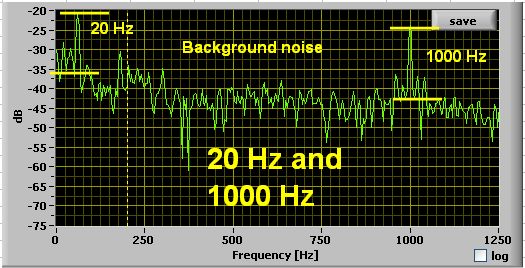
How much of "Background noise" region is really noise, and how much is higher order harmonic distortion and higher order intermodulation distortion?
If it is just noise, it's 10%. Peaks just to left and right of 1000Hz are IMD sum and differences with 20Hz; these are about 12dB below 1000Hz. Each of these is roughly 25% distortion. Totally garbage.
Welcome to DIY.
I highly advocate the use of measurements for design and testing of speakers. Learning curve isn't too steep.
Start with some near field measurements of drivers to get handle on S/N, and then HD results will be clear. Then try multiple tones to check out IMD.
I wouldn't exacly call tonal irregularities of 10-12 db flat...
It's the same case with Beyma drivers. Looks flat from a distance, until you notice the 20 db increments, which suddenly tells another story...
Most (to avoid using the word *all*) speakers have such tightly spaced peaks/dips
They are unavoidable, unless you place the microphone, say, 1 inch from the dome.
The nice frequency response curves you see published everywhere, even by the most respected Speaker makers in the World, are **averaged** (just read the measurement equipment manuals, I'm talking about Brüel and Kjäer or H.P. level stuff) .
Usual averaging is 1/3 octave, which of course averages and smooths peaks/dips within that band into a single value; some high quality makers use 1/6 octave, and 1/20 octave is possible, but only used for "in house" development, never published.
Sweeping with a pure tone , just as-is, will provide "horrible" looking results, so the standard solution is to "warble" it by a definite amount, what I mentioned above.
I consider fwbutler results posted in good faith, and recognizing the "spikey" frequency response for what it is , I mentally averaged it and found it very flat, between 42 and 14000 Hz.
I congratulated him for that
I trust it more than what usually appears in brochures
Most people outside the actual speaker design Industry are unaware of this, and think published curves are "raw", while in fact they are quite "doctored"
Here's an example of a "real" sine wave swept frequency response, Vs. an Industry Standard warbled one:
An externally hosted image should be here but it was not working when we last tested it.
Both are from the same speaker, mic position, room, everything.
For a full explanation, read this UREI manual:
www.studioelectronics.biz/ureipdf/20.pdf
While 1% IM or THD may be considered gross when measuring electronics, most consumer level speakers at peak levels approaching anything like live music levels have distortion on the order of a magnitude higher than that.1% IM is gross.
Fwbutler (and you) can easily confirm this fact with simple sine wave measurements using a real time analyzer.
Just measured some small "full range" speakers rated at 10 watts, which can take short duration 40 watt peaks without burning up, unfortunately they have 100% distortion at about 4.5 watts through most of their range.
If Fwbutler were to play a 20 Hz tone through his speaker at a level of say 70 dB, (if it can reach that without burning the voice coil) a level just above the threshold of audibility at 20 Hz, he would find that the harmonics of 40, 60, 80, 100 Hz all would exceed the fundamental tone by a good margin, well over 100% distortion.
Since the ear is more sensitive to higher frequencies, those harmonics make it easy to think the fundamental is being reproduced at a loud level, especially if the even order harmonics are louder than the odd order.
A surprising amount of even order harmonic distortion can be tolerated and still sound good, as evidenced by the continued popularity of tube (valve) amps and guitar speakers such as the ones JMFahey makes.
On the other hand, a little odd order distortion can go a long way in making music sound "wrong".
That said, in the example below, where the third harmonic of 20 Hz was at around 25% distortion, the speakers still did not sound terribly gross. LF distortion of 10% or less on most pop music is pretty hard to hear.
Well, back to cutting little speaker holes, 12 down, 84 to go...
Art
Attachments
Last edited:
JmFahey. You are correct the frequency response is full of comb filtering-|-||-|.
Especially in a "real" room.Trying to understand my response curves I tried to understand each of the early reflections in the impulse graph, Here is a paragraph of my many page research doc.
Especially in a "real" room.Trying to understand my response curves I tried to understand each of the early reflections in the impulse graph, Here is a paragraph of my many page research doc.
Attachments
weltersys Here is a quick snapshot of a 440 Hz note. It was taken while my wife was running the washer and dryer. There is also traffic from two main roads each with in 300 ft, and 8 houses are being built less than 500 ft away, so a "little" noise is being picked up and inflate the distortion results. Still it under 1%.
The driver by it's self is 85db 1W/1m, and can handle 45 RMS contenious without the horn. With the horn it's 111 db for 1 watt. that is a 20X increase, or 26 (acoustic) db's. So at 85 db the driver would only be using a fraction of a watt.
The driver by it's self is 85db 1W/1m, and can handle 45 RMS contenious without the horn. With the horn it's 111 db for 1 watt. that is a 20X increase, or 26 (acoustic) db's. So at 85 db the driver would only be using a fraction of a watt.
Attachments
I have spent the last few days, while waiting my SPL meter, making sure that my wiring and test setup was accurate. I found many tone controls, and menu selections buried deep in programs, such as Dolby that were affecting the response analysis by the programs. Having cleaned them up and calibrated the Db level, here are the results. First the charts from two programs that now agree right up to the comb filtering signature, “REW” and “ Sound card O Scope”. The frequency response seems to be 30 Hz to 25K Hz. The bass horn peaks at about 45 Hz at about 65-70 db, depending on many room variables, then drops about 25-30 db at 20 Hz.
I am happy, (My wife too). It is still better than I expected. A 40 inch horn drops after 330 Hz. If doubled twice, floor and back wall, it should drop after 82 Hz. Why the 40 Hz of extended bass I do not know?
I am happy, (My wife too). It is still better than I expected. A 40 inch horn drops after 330 Hz. If doubled twice, floor and back wall, it should drop after 82 Hz. Why the 40 Hz of extended bass I do not know?
Attachments
1) congratulations on your very thorough analysis.
Doubly so, because , don't know how to say it, "getting results out of an experiment is fine, but first (and most dificult) is to imagine the experiment itself"
Don't know whether it makes sense to others or not, but consider it a parallel to: "to get good answers, first you need to make good questions".
2) and yes, fully agree that *the room* is incredibly important.
In a way, I deplore that our Civilization insists on building rooms with parallel walls.
Doubly so, because , don't know how to say it, "getting results out of an experiment is fine, but first (and most dificult) is to imagine the experiment itself"
Don't know whether it makes sense to others or not, but consider it a parallel to: "to get good answers, first you need to make good questions".
2) and yes, fully agree that *the room* is incredibly important.
In a way, I deplore that our Civilization insists on building rooms with parallel walls.
Your 26dB of horn gain number is absurd. First off, it's only available in a limitied bandwidth, probably <300Hz. Second, I sincerely doubt you're getting anywhere near 111dB w/m at the very best measurement, unless it's a high-q resonance peak.
Glad you're enjoying your project but ludicrous claims belong on Machina Dynamica's site.
Glad you're enjoying your project but ludicrous claims belong on Machina Dynamica's site.
Interesting tests, thanks for posting them. It does all look too good to be true, so we are a bit skeptical, you know. 
It would be interesting to see the noise floor of the room in a measurement without the speakers playing. Then do a 1Khz for calibration (tell us the SPL if you can), then do you sweeps or noise for frequency response. That gives us all a good place to start.
You might be getting lucky with room gain. That would be nice.
It would be interesting to see the noise floor of the room in a measurement without the speakers playing. Then do a 1Khz for calibration (tell us the SPL if you can), then do you sweeps or noise for frequency response. That gives us all a good place to start.
You might be getting lucky with room gain. That would be nice.
You also can't just measure with a sinewave tone, unless you are very close to the horn. With sinewaves out in the room there can easily have 10s of dBs variation just changing the frequency slightly or moving the mic a little. Warble tone or smoothing of a curve are necessary for any kind of response measurement, because of all reflections.
But you may get some gain down low from room pressurization and a corner could also present another horn expansion if the horn is placed into it. So some free bass might be really happening.
But you may get some gain down low from room pressurization and a corner could also present another horn expansion if the horn is placed into it. So some free bass might be really happening.
My tweeter is rated at 112 db/W/m, Pyle PDBT78.
The HornResp program & Easy Horn predicted 115 db /w/m, I was just being conservative. Predictions attached
I would not run them above 95 db out of respect for the neighbors.
I do listen to Classical music at 70 - 85 db, (have been playing with a new db meter).
At 85 db I read .8 volts into the speakers.
The drivers' , in parallel, combined average impedance is 4 ohms.
I use just a 10Uf cap as a high pass filter instead of a cross-over network
The speaker's bass horn is 45% efficient, so 45% of the electrical energy is converted into acoustic energy.
Would love to do more experiments with my new speakers.
I have to redeem my self because of the earlier bad results that disagreed with REW. I was measuring my speakers and the rulers did not agree.
I have scans of the background noise but they were not calibrated.
The HornResp program & Easy Horn predicted 115 db /w/m, I was just being conservative. Predictions attached
I would not run them above 95 db out of respect for the neighbors.
I do listen to Classical music at 70 - 85 db, (have been playing with a new db meter).
At 85 db I read .8 volts into the speakers.
The drivers' , in parallel, combined average impedance is 4 ohms.
I use just a 10Uf cap as a high pass filter instead of a cross-over network
The speaker's bass horn is 45% efficient, so 45% of the electrical energy is converted into acoustic energy.
Would love to do more experiments with my new speakers.
I have to redeem my self because of the earlier bad results that disagreed with REW. I was measuring my speakers and the rulers did not agree.
I have scans of the background noise but they were not calibrated.
Attachments
Actually in my earlier post of a 1K HZ note with background noise. The top of the 1k was 87.5 db not 90. But that will give you a very good example. Depending on the sawing, hammering, and when the dump trucks go by... Our apparent has thin walls, resonates at 78, and 100 HZ, then again just below 200, So it gets bad. But it's fun, and thanks to folks with good questions and other blogs, I am learning a lot. But still do not understand these speakers, But pleased.
Ok.At 85 db I read .8 volts into the speakers.
The drivers' , in parallel, combined average impedance is 4 ohms.
It means 2V (1W/4 ohms) is : 2/0.8=2.5X higher.
Since 2.5X higher=+8dB ratio; your system has a (measured by you) efficiency of 85+8dB=93dB/1W/1m .
If somebody sees an error in my calculations, I'm open to dialogue
- Status
- This old topic is closed. If you want to reopen this topic, contact a moderator using the "Report Post" button.
- Home
- Loudspeakers
- Multi-Way
- New DIY Horn, impossible results
